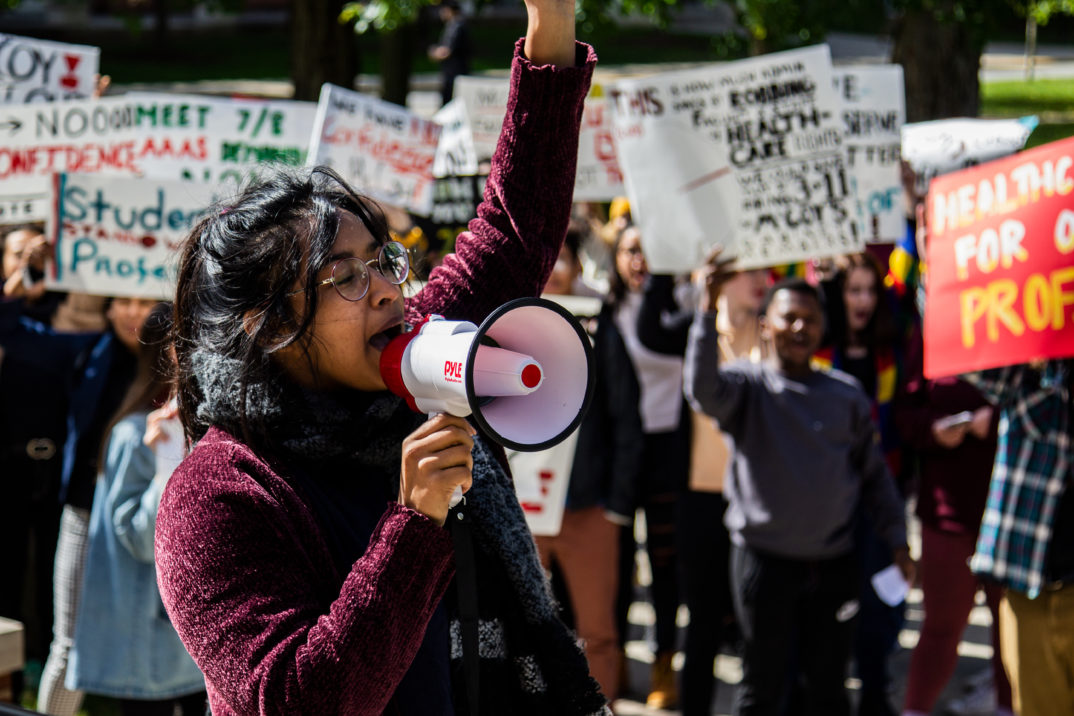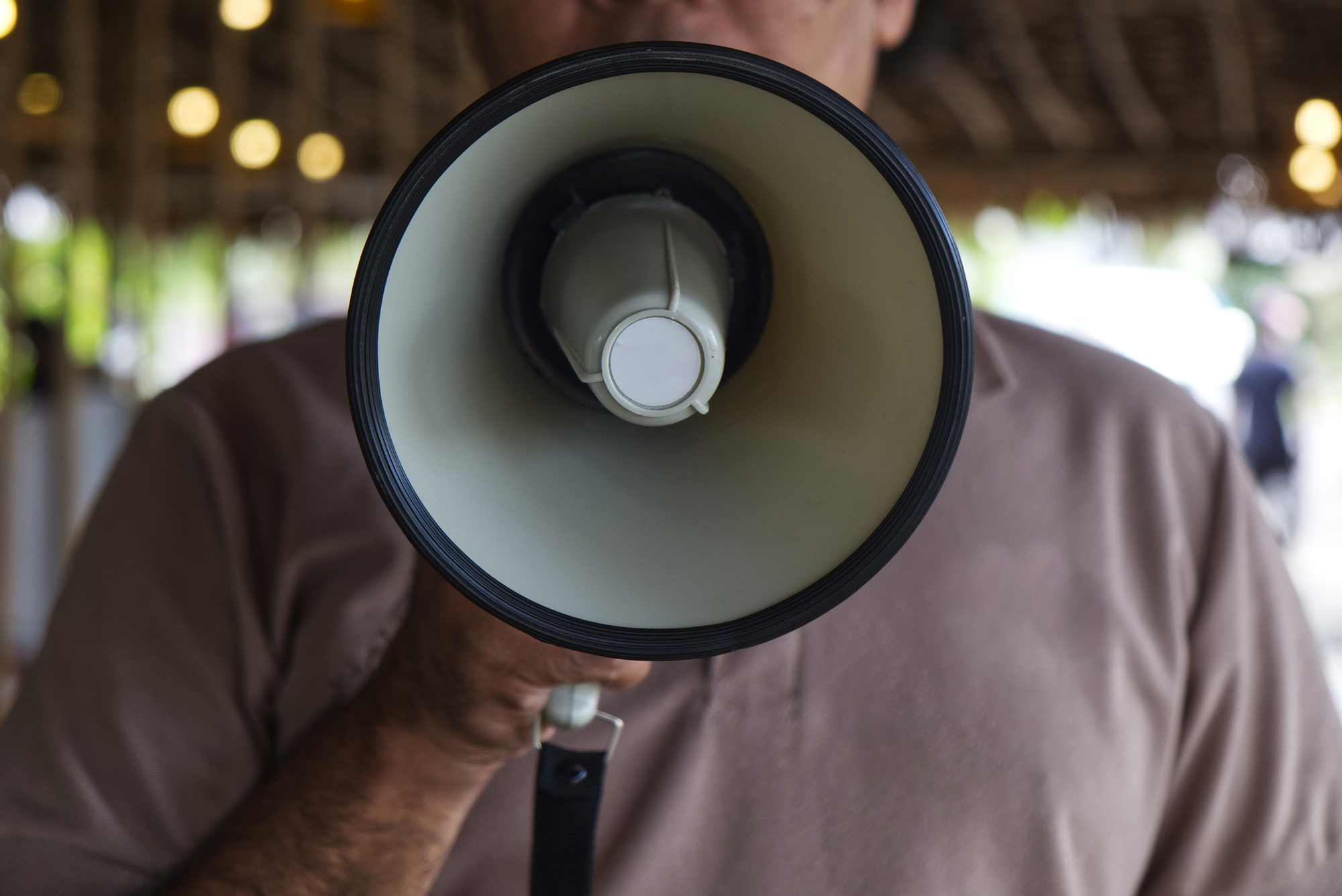Freedom to Protest: An Ethical Examination of the DePauw Student Handbook

On Friday October 12, I walked out of Hoover Hall and unto the cold grey tiles of Stewart Plaza. On that cloudy day, a crowd of students and faculty had begun to form around junior Summer Pappachen, who was holding a megaphone. I had heard about the demonstration through word of mouth and social media: this was probably the best advertised demonstration I had attended at DePauw. In light of how secretive previous demonstrations had been, this felt very strange. Students and faculty had come together to demonstrate against the recent cuts to faculty healthcare. Additionally, the student organizers of the Democratic Socialist Club (DSC) asked President McCoy to abolish the current demonstration policies, which were specifically infringing on the freedoms of students of color. Summer emphasized that President McCoy had not met 7 of the 8 demands set forth by the Association of African American Students (AAAS) last semester. As I stood among my professors and peers, the memory of last semester’s protest was seering in my mind.
During the Jenna Fischer Ubben Lecture that took place Spring Semester 2018, a group of students, including myself, protested against the lack of concern the university had shown surrounding the racist hate crimes that had taken place that same semester. This protest was led by students of AAAS; the students had carefully planned an organized protest that could arguably go against the student handbook policies. The uncertainty came from the ambiguity of the policies themselves. While the student handbook affirms students’ right to “gather, speak, and peaceably demonstrate,” there is ambiguity as to what is considered peaceful, safe and non-disruptive.
The student handbook reads,
“We encourage the exchange of ideas in an environment of respect and civil discourse. Furthermore, we recognize that rights of one individual or group to gather, speak, and peaceably demonstrate should not infringe on the ability of others to live, learn, and work in our community. Infringement includes, but is not limited to, actions such as physically limiting egress or ingress, creating a physically unsafe environment, or preventing a scheduled campus event from occurring.”
This is seemingly a reasonable request: do not endanger other students or limit their liberties in pursuit of free speech. Like the first Amendment of the U.S Constitution, the right to peacefully assemble is protected at DePauw University. However, even the First Amendment is riddled with ambiguity. Who exactly has the power to determine what peace looks like? Whose standards of appropriate conduct are being followed and who do these standards privilege and who do they harm?
At DePauw, the Vice President of Student Affairs (or their designee) is responsible for determining whether a demonstration has been “disruptive” of everyday affairs. The Vice President works in conjunction with Greencastle Police, Public Safety, and the Demonstration Response Team to assess whether the demonstration follows any of the four “disorderly conduct” guidelines. A demonstration is in violation of school policies if a person participating:
(1) engages in fighting or in tumultuous conduct;
(2) makes unreasonable noise and
(3) continues to do so after being asked to stop; or
(4) disrupts a lawful assembly of persons
At first, one is given the sense that what is considered “peaceful” will be assessed only by the Vice President. This can be considered both good and bad, because there is only one person’s subjectivity involved and they can be directly held accountable for their opinions. On the other hand, this individual is still following their subjective opinions on whether something is “unreasonably noisy.” While these duties would be given to anyone holding the position of Vice President, this role is currently held by one of the only black administrators of DePauw.
There are a couple things to consider in regards to the Vice President’s role within demonstration policy enforcement, and his identity. Historically, in the United States, citizens have been held accountable to white standards of conduct, so normative whiteness dictates what is considered an appropriate noise level for speech or what language is proper to use. Furthermore, when students are asked not to make “unreasonable levels of noise,” the question becomes, by whose standards? Since DePauw is not an institution that operates outside of society’s norms and American history, this standard of noise is a white standard. At DePauw University, most demonstrations are led, planned and attended by students of color, which means these black and brown students are more likely to be judged as acting inappropriately. One might point to the Vice President, the man who has the determining power, and argue that as a black man, he is more likely to “do right” by the students of color on campus. This is not necessarily untrue; however, one must not forget that normative whiteness is structural, and within an institution such as DePauw, one does not need to be white to perpetuate white norms.
Nevertheless, as the student handbook later clarifies, the Vice President works with Greencastle Police, Public Safety, and the Demonstration Response Team to determine whether the demonstration and the individuals participating in it are acting according to student guidelines. This clarification implicates many more people in the assessment process, which, as mentioned, can be viewed both positively and negatively. The participation of the Greencastle Police and Public Safety has new and important implications. After the demonstration during the Ubben Lecture last semester, we neatly filed out of the auditorium to find a row of cop cars waiting outside. We felt a collective sense of fear: would the demonstration end with a dead black or brown body?
It is imperative to consider whose safety is being prioritized. How is the positionality of students being taken into consideration when the police department is heavily involved in demonstrations? For many black and brown students, the sight of police does not conjure feelings of safety, because too often when people of color engage with police, they end up handcuffed or dead. One must understand that people with different racial and ethnic identities hold distinct views about the police, because of the racialized experience they have had throughout their lives. This racialized experience informes whether they feel safety of fear when the police is near. Historically, black people have been disproportionately targeted by the police, and their bodies have been highly criminalized. Furthermore, the DePauw student policies should be sensitive and cognisant of the structural injustices that are perpetuated against people of color.
The handbook emphasizes that simply because a demonstration causes discomfort, it does not mean it is in violation of student policies. This is a very important inclusion within the demonstration guidelines; however, the policies lack clarity in other ways. For example, the handbook states that demonstrations should not disturb lawful assemblies, and defines unlawful assemblies as “an assembly of five (5) or more persons whose common object is to commit an unlawful act, or a lawful act by unlawful means. Prior concert is not necessary to form an unlawful assembly.” By this definition, one can consider an Ubben Lecture a lawful assembly. Furthermore, is it against the student guidelines to demonstrate during an Ubben lecture, where the speaker’s ability to continue their lecture is limited? Would chanting outside the meeting place of the Board of Trustees, like the latest protest on October 12, be considered unreasonable noise? If the people present during the protest feel uncomfortable, then it seems like the demonstration is not in violation, but what about if they feel unsafe? These questions do not seem to have clear answers.
While it is proactive that the guidelines are extensive, they do not provide students with clarity as to how to proceed independently. The demonstration policies outline that students should seek help from the Vice President or the Demonstration Response Team if they have doubts about whether their demonstration follows the guidelines; however, this does not take into account that students might not want help from the administration if they are demonstrating against the administration or if they want their demonstration to have no administrative involvement. It is important to center student and faculty autonomy, because their voices should be independent in pursuit of justice. However, these guidelines are heavily emphasized by the administration because the University wants to ensure a safe environment for all. Yet as a student of color myself, I cannot help but feel that the University does not trust students of color to behave in a safe and orderly manner. After all, by definition, protests and demonstrations are non-violent — and student leaders organizing these demonstrations are aware of that fact.
After last semester’s demonstration, I waited for everyone I knew to come outside, when I noticed some students being harassed and touched by a man who had attended Jenna Fischer’s lecture. The students were only trying to get into their car after voicing how unsafe they felt on their own campus. During the demonstration at the Board of Trustees meeting, we chanted outside their room in Hoover Hall. As we stood outside, a white student banged on the doors of the meeting room. My heart froze. She was not aware of the fear that students of color feel during any demonstration — because students of color can more easily be painted as violent and aggressive. Any breach of university policies can signify further limitations and restrictions for a student of color. I wondered what thoughts would pop into the heads of those inside that meeting room and who they imagined knocking on the door…
While seeking to improve their environment, students, specifically students of color, must juggle an array of considerations and precautions. The student handbook should take some weight off students so that they can think more freely. Instead, the handbook is a confusing space for students to navigate. How can the rules meant to create order, create ethical concerns for those trying to follow them? Should students be allowed to “break” the student guidelines in pursuit of more ethical institutional treatment? Before students feel forced to enter this space, handbook policies should shift in a more transparent and ethical direction.




